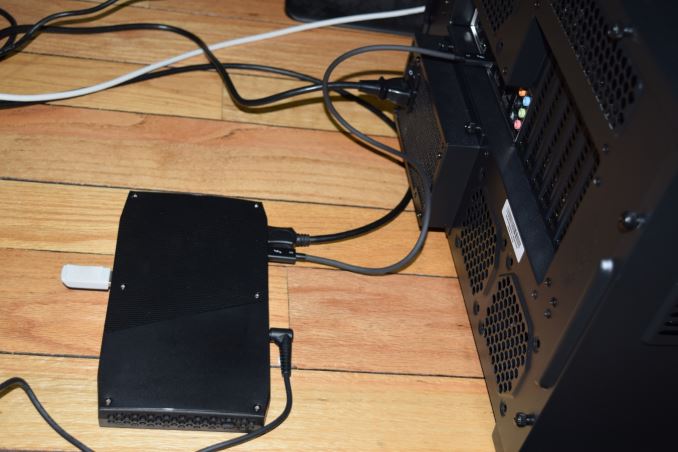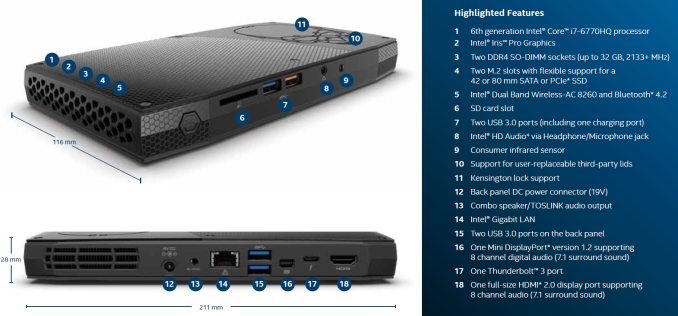The Intel Skull Canyon NUC6i7KYK mini-PC Review
by Ganesh T S on May 23, 2016 8:00 AM ESTMiscellaneous Aspects and Concluding Remarks
One of the more impressive aspects of the Skull Canyon NUC6i7KYK is the reappearance of Thunderbolt in a mini-PC. We have already covered Thunderbolt 3 in good detail. From the perspective of a Skull Canyon evaluation, the Thunderbolt 3 port does deserve a bit of attention. It must be noted that this USB Type-C port can also act as a USB 3.1 Gen 2 host port. Our evaluation of this feature is in two parts - we first hooked up a SanDisk Extreme 900 1.92TB USB 3.1 Gen 2 SSD and ran a quick speed test. We were able to see results similar to our review numbers, indicating that the USB 3.1 Gen 2 mode was indeed active. For the Thunderbolt part, we decided to check out Thunderbolt networking with our direct-attached storage testbed.
A Thunderbolt cable between two PCs is enough to create a Thunderbolt network
Connecting the Thunderbolt ports on the two machines and allowing the PCs to talk to each other automatically creates a 10Gbps network adapter. For a setup with just two machines, it is enough to just set static IPs on the interfaces of both machines in the same subnet, and setting the network location to private so that the machines can talk to each other. We configured a RAM drive on the testbed and mapped it as a network drive on the NUC6i7KYK, Running CrystalDiskMark on the mapped drive showed read speeds of 700 MBps and write speeds of 620 MBps, indicative of a 10Gbps link. The gallery below presents some screenshots of the benchmarks as well as the Thunderbolt networking setup steps.
Moving on to the business end of the review, let us get the complaints out of the way - While the size and form-factor of Skull Canyon are impressive, the acoustic profile is not that great. We would gladly trade a modest increase in the footprint of the system for lower fan noise. That said, the fan noise is in no way comparable to the BRIX Gaming lineup. It is just that it is not as silent as the traditional NUCs.
On the board layout front, we are unable to fathom why the CPU's PCIe lanes are not used at all. It would have been great to have a dual-port Alpine Ridge controller hang directly off the CPU's PCIe lanes. Finally, the ports on the chassis could have done with better spread. The two pairs of USB ports are such that one occupied port ends up making it difficult to utilize the other one in the pair. A port on one of the sides, or, on the lid (without relying on third-party designs), would be very welcome.
But with the above caveats in mind, Skull Canyon is definitely a great product. Simply put, it packs the most punch among systems with similar footprints. It is excellent for casual gamers, but, unfortunately, stops short of being a replacement for systems like the Zotac ZBOX MAGNUS EN970 or the ASRock VisionX 471D - two small form-factor PCs that integrate discrete GPUs at the cost of a larger footprint compared to Skull Canyon. The Thunderbolt 3 port, with an external GPU dock, can somewhat make up for the lack of a discrete GPU for gamers. However, the cost factor becomes a major issue. The 4C/8T configuration of the Core i7-6770HQ is also attractive to consumers looking for a small form-factor system with a powerful CPU, but, they must remember that some price premium is being paid for the Iris Pro graphics.
I am actually looking forward to what vendors like Zotac and ASRock can do with a similar design. If they could take a Skylake-H processor without Iris Pro (say, Core i7-6820HQ), and use the PCIe lanes off the CPU to hook up a mobile discrete GPU, it could deliver the best of both worlds - all the 45W TDP of the CPU can be used to provide raw processing power for CPU-intensive workloads, while a dGPU can handle graphics duties with a separate power budget.
To summarize, Intel has indeed managed to change the game with the NUC6i7KYK. A look at the increase in the gaming capabilities over the previous generation 'gaming' NUCs make the Skull Canyon updates to appear evolutionary in nature. However, the overall platform capabilities (including a much more powerful -H series CPU instead of a -U series CPU, as well as the integration of Thunderbolt 3 and dual M.2 PCIe 3.0 x4 SSD slots) are enough to justify the price premium ($650 for the barebones configuration).


















133 Comments
View All Comments
jasonelmore - Monday, May 23, 2016 - link
it will work fine. Intel has been using the Razer External GPU Chassis and they even commented on it here on Anandtech Comments, on the last article that was posted about it. DMI 3.0 still does 4GB/s and the CPU is not transferring huge amounts of bandwidth hungry texture data back and forth with the CPUlmcd - Monday, May 23, 2016 - link
Plus the fact that PCIe 2.0 x4 was shown to be the tipping point between bandwidth limited and not for single GPU systems, I believe. 3.0 is twice that, and 2.0 4x barely even throttled that one graphics card -> there's a decent bit of overhead available.Cuhulin - Wednesday, May 25, 2016 - link
The only question I have about the Razer Core approach is price. Wouldn't it be better to simply buy a Razer Stealth instead?fanofanand - Monday, May 23, 2016 - link
Grandpa/Grandma don't need a 1k PC. They would be adequately served by the PC sticks. This would be massive overkill for Fakebook browsing. This is a product desperately searching for a niche market.gurok - Monday, May 23, 2016 - link
You say that, but they've incorporated a skull design specifically for grandpas/grandmas.Cuhulin - Wednesday, May 25, 2016 - link
Let's see whether you think the same way when you are a grandparent, or at least old enough to be one. I am a grandfather, and I need a decent PC for my 4k gaming, among other things - which means way more than 1k at this time. (I have at least 2k in the 3 4k monitors on my desk, for one thing). I suck at FPS games these days - reflexes just aren't what they were decades ago - but I still have fun. So maybe the ageism should be put away?Calista - Monday, May 23, 2016 - link
Why would you spend 1000 dollars on something a 300 dollar machine does almost just as well? No, this is a really an odd product which can't be upgraded, which can't play current games and which cost an arm and a leg. And why, to save a little bit of space on a desk already housing a (most likely) large monitor, large keyboard and a mouse. I could see the charm of something like this had we had easy access to MXM (or similar standard) modules. But for anyone else far better and almost as small options seem to exist.milkod2001 - Tuesday, May 24, 2016 - link
for $1000 one can get same specs laptop which comes with screen and keyboard already = much better buy/value.The only thing when NUCs make sense is if you need to hook it behind telly and use it as streaming device otherwise any other option gives you much more.
Calista - Tuesday, May 24, 2016 - link
Yeah. I have never understood this "I need a high-end PC, thus I buy an expensive PC which will only be high-end for the next 12 months" while keeping it for the next three years. Either we need high-end components and then we will always need the latest high-end components or else we don't need high-end components and then it doesn't make sense to buy expensive bleeding edge stuff.JBSZQn1LI06L8j33 - Tuesday, May 24, 2016 - link
i am thinking about it, but it is too expensive right now. it needs to be $400 and should come with windows usb. Right now it is basically laptop without keyboard, screen, touch-pad and external power supply. I really like the form factor ...